AQUAPONICS WITHOUT ELECTRICITY
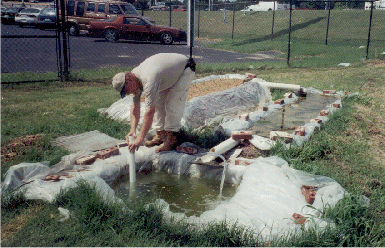
In order to provide poor people with
adequate protein in their diets while
also allowing them to grow vegetables
hydroponically, this simple aquaponics
system is offered as a gift of grace
from God.
Aquaponics is a combination of
aquaculture (Raising captive fish)and
hydroponics (raising plants without soil)
The challenge in practicing
aquaponics without electricity is in
pumping the water from the bottom of the
fish tank where the manure collects. The
manure is what feeds the plants in the
hydroponic growing bed.
Hydroponic Production
Hydroponically grown vegetables suffer
less loss from disease than those grown in
the soil. They also grow faster and usually
have greater production and quality.
The type of hydroponic production used
in this system is called "Ebb and Flow"
because the growing bed is flooded with
water and is then allowed to drain.
This is done several times a day to keep
the growing media moist so that the plants
do not suffer stress from lack of water.
In aquaponic production, the act of
irrigating the plants also fertilizes them,
since the water carries the fish manure to
the media in which the plants grow.
Bacteria in the growing beds decompose the
manure and make the nutrients available to
the plants. At the same time, the removal
of the manure from the water by the growing
media filters the water before it returns to
the fish, preventing the decomposition of
the manure inside the fish tank and therefor
reducing the Oxygen levels to dangerously
low levels.
Aquaculture
The fish used should preferably be
Tilapia. They are disease resistant and
also tolerant of relatively low Oxygen
levels. They also grow rapidly, have a
good feed conversion rate and begin
spawning at only three months of age.
This fish eatts mainly vegetable matter
such as algae and chopped up leaves of
edible plants.
Tilapia meat tastes good and is
becoming popular in many areas of the
world.
If Tilapia are not allowed in an
area where these systems are needed, a
fish with similar characteristics
should be found locally.
Operation
This manual aquaponics system is made
possible by a simple pump made of a piece
of 8cm to 10cm (3" or 4") PVC pipe with an
elbow at one end.
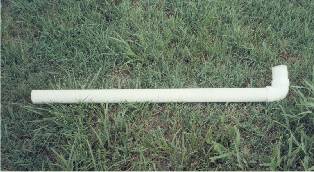
A 8cm piece of pipe is
inserted into the elbow so that a cap can
be attached to this end. Then holes are
drilled into the cap so that water can
flow through them into the pipe. Two pumps
can be made from one section of PVC pipe.
There are other hand operated pumps that
can be substituted if the people have the
money for them. But, if they don't, this
simple device can be built at a very low
price.
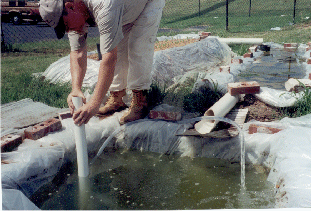
The cap end of this pipe is thrust into
the deepest portion of the tank bottom and
held there until the manure laden water in
the pipe comes up to the same level as that
of the tank itself. The person then places
their hand over the other end to create a
suction(as you would do with a pipette).
Then the pipe is leaned up out of the water
with the holes in the cap pushing against
the water(with the cap facing away from the
operator) so that none flows back out of the
pipe. Continue leaning the pipe up until the
water flows out the other end into the
growing bed. This is repeated until the
growing bed is full to the surface of the
growing media.
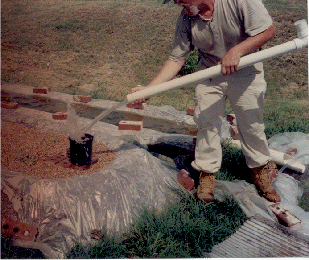
When the bed is full the board at the far
end of the bed is removed, allowing the water
to flow into the algae bed. The purpose of
this bed is to grow algae for the fish to eat
and to remove more nutrients from the water
before it flows back into the fish tank. This
decreases the risk of an overgrowth of bacteria
in the tank which would use up Oxygen needed by
the fish.
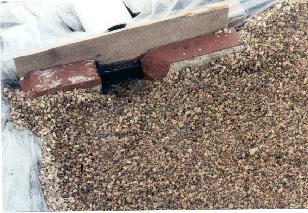 You can tell if the fish need more Oxygen
by their gulping water at the surface of the
tank in order to force Oxygen into the water.
This exertion slows production of the fish
and should be avoided.
Nutrients that remain in the water when
it leaves the growing bed are available in the
adjacent pool for production of algae which
then flows into the tank to feed the fish.
Since these nutrients are used by the algae,
the water is further purified in the pool
before it returns to the fish. The algae is
supplemented by chopped up edible leaves
which are small enough for the fish to eat.
You can tell if the fish need more Oxygen
by their gulping water at the surface of the
tank in order to force Oxygen into the water.
This exertion slows production of the fish
and should be avoided.
Nutrients that remain in the water when
it leaves the growing bed are available in the
adjacent pool for production of algae which
then flows into the tank to feed the fish.
Since these nutrients are used by the algae,
the water is further purified in the pool
before it returns to the fish. The algae is
supplemented by chopped up edible leaves
which are small enough for the fish to eat.
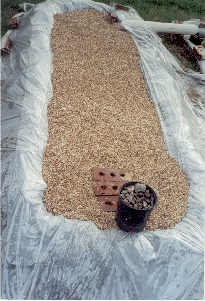
When water is poured into the growing bed
it is poured over a pot or bowl of gravel, a
grid of sticks or some other device meant to
break up the water to aerate it. There needs
to be another one of these devices under the
outflow from the growing bed and another
under the outflow of the algae pool going
into the fish tank.
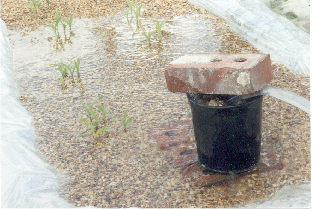 In addition to this aeration, someone
needs to spend about 10 minutes, two or three
times a day dipping water from the tank and
pouring it back into the tank with a gourd or
bowl for further aeration.
In addition to this aeration, someone
needs to spend about 10 minutes, two or three
times a day dipping water from the tank and
pouring it back into the tank with a gourd or
bowl for further aeration.
Construction
The first step in constructing the system is
to lay out sting on the ground indicating where
the components will be and outlining them for
construction. The holes are then dug for the
fish tank and for the algae bed with the dirt
being used to construct the growing bed.
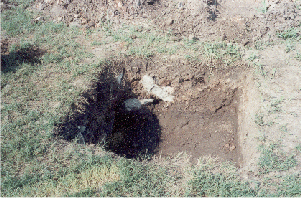
The tank is about 1M x 1M x 1M (3'x3'x3')
with the bottom sloping to a low point to
collect the manure. This size tank would
hold 100 fish.
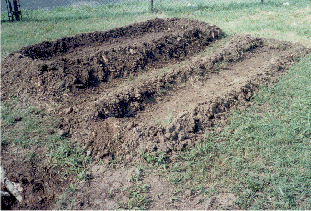 About 1/2 Meter (a couple feet) away from
the hole dug for the fish tank a growing bed
is constructed with the dirt removed from
this hole and from a shallow hole dug for an
algae bed. The growing bed for 100 fish is
1.2M x 7.2M (4'x24')and is as tall as is
possible given the amount of dirt removed
from the two holes. It should have 20cm (8")
sides built up above the surface to retain a
six inch layer of pea gravel, fired bits of
clay or other inert growing media. Manure
collects in the growing media and is
decomposed by the bacteria. The nutrients
are then available to the plants and are
prevented from flowing back to the fish tank
where they would decompose, using up the
Oxygen and killing the fish by asphyxiation.
About 1/2 Meter (a couple feet) away from
the hole dug for the fish tank a growing bed
is constructed with the dirt removed from
this hole and from a shallow hole dug for an
algae bed. The growing bed for 100 fish is
1.2M x 7.2M (4'x24')and is as tall as is
possible given the amount of dirt removed
from the two holes. It should have 20cm (8")
sides built up above the surface to retain a
six inch layer of pea gravel, fired bits of
clay or other inert growing media. Manure
collects in the growing media and is
decomposed by the bacteria. The nutrients
are then available to the plants and are
prevented from flowing back to the fish tank
where they would decompose, using up the
Oxygen and killing the fish by asphyxiation.
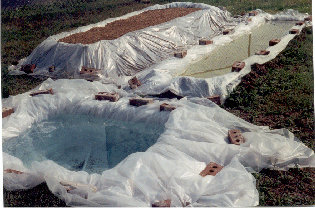
The 60cm x60cm x 7.2M (2'x2'x24') algae
pool is 60cm (2') from the growing bed and
parallel to it. Exiting the growing bed,
there is a pipe or roof tile leading from the
end farthest from the fish tank growing bed,
extending out over the algae pool. There is
also one leading out from the near end of the
algae pool extending out over the fish tank.
There is a board placed in front of the
pipe or roof tile which exits the growing bed
so that water builds up in the bed and then
flows out slowly or the board can be removed
for faster removal of the water. This
provides an ebb and flow system for
irrigating the plants in the bed.
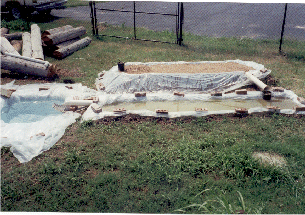
This whole system is covered by a sheet
of plastic about 5M x 12M (15'x40') to
prevent water from leaking out of the system.











